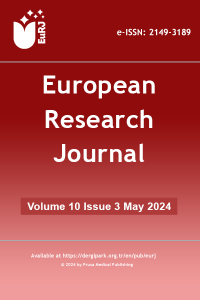Abstract
Objectives: The aim of this study is to investigate the hiatus defect diameter by measuring on multi-detector computed tomography images in hiatal hernia patients.
Methods: The multi-detector computed tomography images of 50 patients and 50 individuals in control group included in this study were investigated. The hiatus surface area (cm²), hiatus antero-posterior and transverse diameters (cm), and the thickness of both diaphragmatic crura (mm) were measured by reformatting contrast-enhanced thoraco-abdomino-pelvic computed tomography images using the region of interest method.
Results: In this study, a significant difference was obtained among groups according to hiatus surface area, hiatus antero-posterior, and transverse diameter measurements, and both left and right diaphragmatic crural thickness measurements (P<0.001). In the patient group, the cut-off values were determined by using ROC analysis, and the values above these cut-off values enabled a hernia diagnosis with high sensitivity and specificity.
Conclusions: Measuring the hiatus surface area on multi-detector computed tomography images could serve as a supplementary criterion for diagnosing of hiatal hernia.
Ethical Statement
This work was conducted in accordance with the Declaration of Helsinki as well as reviewed and approved by the ethics committee of our institution. (Approval date: 05.07.2023 and no: 2011-KAEK-25 2023/07-26)
Project Number
2011-KAEK-25 2023/07-26
References
- 1. Zheng Z, Liu X, Xin C, et al. A new technique for treating hiatal hernia with gastroesophageal reflux disease: the laparoscopic total left-side surgical approach. BMC Surg. 2021;21(1):361. doi: 10.1186/s12893-021-01356-3.
- 2. Watson TJ, Ziegler KM. The Pathogenesis of Hiatal Hernia. Foregut. 2022;2(1):36-43. doi:10.1177/26345161221083020.
- 3. Shamiyeh A, Szabo K, Granderath FA, Syré G, Wayand W, Zehetner J. The esophageal hiatus: what is the normal size? Surg Endosc. 2010;24(5):988-991. doi: 10.1007/s00464-009-0711-0.
- 4. Moten AS, Ouyang W, Hava S, et al. In vivo measurement of esophageal hiatus surface area using MDCT: description of the methodology and clinical validation. Abdom Radiol (NY). 2020;45(9):2656-2662. doi: 10.1007/s00261-019-02279-7.
- 5. Boru CE, Rengo M, Iossa A, et al. Hiatal Surface Area's CT scan measurement is useful in hiatal hernia's treatment of bariatric patients. Minim Invasive Ther Allied Technol. 2021;30(2):86-93. doi: 10.1080/13645706.2019.1683033.
- 6. Ouyang W, Dass C, Zhao H, Kim C, Criner G; COPDGene Investigators. Multiplanar MDCT measurement of esophageal hiatus surface area: association with hiatal hernia and GERD. Surg Endosc. 2016;30(6):2465-2472. doi: 10.1007/s00464-015-4499-9.
- 7. Kumar D, Zifan A, Ghahremani G, Kunkel DC, Horgan S, Mittal RK. Morphology of the Esophageal Hiatus: Is It Different in 3 Types of Hiatus Hernias? J Neurogastroenterol Motil. 2020;26(1):51-60. doi: 10.5056/jnm18208.
- 8. Sfara A, Dumitrascu DL. The management of hiatal hernia: an update on diagnosis and treatment. Med Pharm Rep. 2019;92(4):321-325. doi: 10.15386/mpr-1323.
- 9. Batirel HF, Uygur-Bayramicli O, Giral A, et al. The size of the esophageal hiatus in gastroesophageal reflux pathophysiology: outcome of intraoperative measurements. J Gastrointest Surg. 2010;14(1):38-44. doi: 10.1007/s11605-009-1047-8.
- 10. Franzén T, Tibbling L. Is the severity of gastroesophageal reflux dependent on hiatus hernia size? World J Gastroenterol. 2014;20(6):1582-1584. doi: 10.3748/wjg.v20.i6.1582.
- 11. Kahrilas PJ. GERD pathogenesis, pathophysiology, and clinical manifestations. Cleve Clin J Med. 2003;70 Suppl 5:S4-19. doi: 10.3949/ccjm.70.suppl_5.s4.
- 12. Vandenplas Y, Hassall E. Mechanisms of gastroesophageal reflux and gastroesophageal reflux disease. J Pediatr Gastroenterol Nutr. 2002;35(2):119-136. doi: 10.1097/00005176-200208000-00005.
Abstract
Project Number
2011-KAEK-25 2023/07-26
References
- 1. Zheng Z, Liu X, Xin C, et al. A new technique for treating hiatal hernia with gastroesophageal reflux disease: the laparoscopic total left-side surgical approach. BMC Surg. 2021;21(1):361. doi: 10.1186/s12893-021-01356-3.
- 2. Watson TJ, Ziegler KM. The Pathogenesis of Hiatal Hernia. Foregut. 2022;2(1):36-43. doi:10.1177/26345161221083020.
- 3. Shamiyeh A, Szabo K, Granderath FA, Syré G, Wayand W, Zehetner J. The esophageal hiatus: what is the normal size? Surg Endosc. 2010;24(5):988-991. doi: 10.1007/s00464-009-0711-0.
- 4. Moten AS, Ouyang W, Hava S, et al. In vivo measurement of esophageal hiatus surface area using MDCT: description of the methodology and clinical validation. Abdom Radiol (NY). 2020;45(9):2656-2662. doi: 10.1007/s00261-019-02279-7.
- 5. Boru CE, Rengo M, Iossa A, et al. Hiatal Surface Area's CT scan measurement is useful in hiatal hernia's treatment of bariatric patients. Minim Invasive Ther Allied Technol. 2021;30(2):86-93. doi: 10.1080/13645706.2019.1683033.
- 6. Ouyang W, Dass C, Zhao H, Kim C, Criner G; COPDGene Investigators. Multiplanar MDCT measurement of esophageal hiatus surface area: association with hiatal hernia and GERD. Surg Endosc. 2016;30(6):2465-2472. doi: 10.1007/s00464-015-4499-9.
- 7. Kumar D, Zifan A, Ghahremani G, Kunkel DC, Horgan S, Mittal RK. Morphology of the Esophageal Hiatus: Is It Different in 3 Types of Hiatus Hernias? J Neurogastroenterol Motil. 2020;26(1):51-60. doi: 10.5056/jnm18208.
- 8. Sfara A, Dumitrascu DL. The management of hiatal hernia: an update on diagnosis and treatment. Med Pharm Rep. 2019;92(4):321-325. doi: 10.15386/mpr-1323.
- 9. Batirel HF, Uygur-Bayramicli O, Giral A, et al. The size of the esophageal hiatus in gastroesophageal reflux pathophysiology: outcome of intraoperative measurements. J Gastrointest Surg. 2010;14(1):38-44. doi: 10.1007/s11605-009-1047-8.
- 10. Franzén T, Tibbling L. Is the severity of gastroesophageal reflux dependent on hiatus hernia size? World J Gastroenterol. 2014;20(6):1582-1584. doi: 10.3748/wjg.v20.i6.1582.
- 11. Kahrilas PJ. GERD pathogenesis, pathophysiology, and clinical manifestations. Cleve Clin J Med. 2003;70 Suppl 5:S4-19. doi: 10.3949/ccjm.70.suppl_5.s4.
- 12. Vandenplas Y, Hassall E. Mechanisms of gastroesophageal reflux and gastroesophageal reflux disease. J Pediatr Gastroenterol Nutr. 2002;35(2):119-136. doi: 10.1097/00005176-200208000-00005.
Details
| Primary Language | English |
|---|---|
| Subjects | General Surgery, Radiology and Organ Imaging |
| Journal Section | Original Articles |
| Authors | |
| Project Number | 2011-KAEK-25 2023/07-26 |
| Early Pub Date | March 18, 2024 |
| Publication Date | May 4, 2024 |
| Submission Date | November 18, 2023 |
| Acceptance Date | February 7, 2024 |
| Published in Issue | Year 2024 Volume: 10 Issue: 3 |



